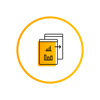With the 8.1 platform update, Inductive Automation massively expanded Ignition’s functionality, security and capability. If you’re using a solution built with Ignition 7.9 and want to upgrade, then this post is for you. We’ll give you an overview of the Ignition 8.1 update and provide the exact steps you’ll need to perform the upgrade.
What is Ignition?
Ignition is a web-based industrial automation platform that empowers you to track, display, and analyze your plant data in real-time. Top-tier SCADA and MES solutions built-in Ignition are powerful, intuitive and virtually bulletproof. Learn more here.
11 Reasons Why You Should Upgrade to Ignition 8.1
1. Switch from Vision to Perspective 
When you upgrade, you’ll get the option to use the mobile-first Ignition Perspective module. Perspective allows you to build beautiful, responsive applications for better mobility, visualization and accessibility at every level. But it doesn’t come automatically. You’ll have to turn off your old Vision solution to take advantage of it.
With 7.9, Perspective isn’t even an option. So, if you think you want to take advantage of mobile design, GPS integration, barcode scanning, SSL encryption and more, you’ll want to upgrade to Ignition 8.0 or 8.1.
2. Fully Web-Based
With 8.1, Ignition becomes fully web-based! With 8.1, there’s now zero client installation. Any browser connected to your network can access the solution (making your IT department happy).
3. Multi-Factor Authentication
Another feature that will make your IT department happy? Full identity provider (IdP) support. You can now use your existing two-factor (2FA) or multi-factor authentication. This includes support for popular IdPs such as Okta, Ping Identity, Active Directory Federation Services, and Duo.
4. Efficient Tagging
The entire tag engine got a complete, top-down rewrite that’s way more efficient on network load. Everything in the tag system is now “report by exception” instead of “publish and subscribe”. This change decreases overall network traffic, resulting in improved network performance.
5. Improved UDT Inheritance
Ignition 8.1 also brought more advanced UDT inheritance capabilities, which we believe should make all the SCADA PLC programmers out there jump for joy. How it works is that once you have a single data type created in Ignition, you can extend these properties to other data types to add additional members or override default values. You can also override parent properties.
 6. Project Inheritance
6. Project Inheritance
With 8.1, you don’t just get UDT inheritance; you’ll also get project inheritance! This means that you can create an inheritable project that uses the same views, windows, scripts, resources, templates, and more from another project. And just like with properties, you can decide that a specific resource inherited from a parent project can be changed to suit the child project. You can configure project inheritance in the Project Settings.
7. Built-in Java
Java is now included in the Ignition build, so you don’t need to install it separately like you did in previous versions.
8. Automatic & Active Updates
In Ignition 8.1, updates and new features are now being actively pushed. In 7.9, updates and new features were only added when there was a big enough need for it. Ignition 7.9 LTS support runs until 2025, and you’ll only get a new version when there’s a critical issue. Upgrading to 8.1 gives you new features as soon as they’re available.
9. Built-in Change Management
With Ignition 8.1, everything has been moved to the file system. You can now leverage change management via version control and source control. You’ll have to do some work to implement it, but this feature set isn’t even possible in Ignition 7.9.
10. Improved Multi-Developer Support
- Lock-free editing - Multiple people can work together and make changes to a project at the same time. An unlimited number of Designers can be open concurrently and modifying any resource in the Designer doesn't lock it.
- Concurrent Users UI - Version 8.0.10 added the Concurrent User Interface that allows users to see which project resources are open in other Designer instances, the names of the users that have them open, and when a project update is available.
- Conflict Resolution - When you save your project, the Save Project dialog pops up allowing you to select the items you want to save. If there are any conflicts, the Designer will ask you to update your project and the conflict resolution screen will open automatically.
11. OPC/UA Security
Open Process Connectivity (OPC) allows data to be passed between hardware devices and software like Ignition. In 8.1, Open Process Connectivity Unified Architecture (OPC UA) is managed through a distributed, secure, and efficient system that keeps overall costs low.
Some items to note:
- Ignition can only connect directly to devices over Ethernet.
- Ignition can only connect directly to devices for which there is an Ignition device driver.
- Ignition can connect to third-party OPC servers via OPC UA or OPC-DA (using the OPC-COM module) for devices that do not have a supported driver.
Ignition supports all common encryption schemes by connecting to the OPC UA server over TCP/IP and then sending data by encoding it into an efficient format as defined by the OPC UA specification. Device connections can be managed in the Ignition OPC UA Module.
Before You Move Forward
Real quick! While Inductive Automation is dedicated to backward compatibility, there are still some considerations to be aware of. Depending on your setup, it’s not always recommended to upgrade from Ignition 7.9, and we’ll discuss those instances first before moving on.
Note These Discontinued Features
Ignition 8.1 changed a lot of things.
- Removal of support for External Database “SQLTags” Providers
- Removal of support for 32-bit platforms other than ARM
- Discontinuation of the Project Rollback feature
- Discontinuation of the Vision Mobile Module (replaced by Perspective)
- Incompatibility with 3rd Party Ignition 7 Modules
- Discontinuation of Default Security Certificate Provisioning
One big change was the ending of support for the Vision Mobile Module, which has been replaced by the Ignition Perspective Module. Perspective is more dynamic and can be installed on iOS and Android devices.
Always Follow Best Practices
It should go without saying that you should follow all best practices before upgrading. This means making sure you’re installing Ignition 8.1 on a separate computer and testing for complete functionality and interoperability before deploying Ignition 8.1 to production. This is especially true if you’re making the leap from 7.9 to 8.1.
Contact us if you want help upgrading.
Steps to Upgrade to Ignition 8.1
And now, the moment you’ve been waiting for. We worked hard to outline in detail the exact steps you’ll need to upgrade your system to Ignition 8.1. But if you want the short answer, here’s a quick overview:
- Create an additional VM to be used as the Upgrade VM.
- Clone the existing Production solution to the Upgrade VM.
- Upgrade the Upgrade VM from 7.9.x to 8.1.x
- Validate application functionality and make corrections as necessary on the Upgrade VM.
- Deploy to production (approximately 2-hour system downtime).
- Take Ignition/Database backups of Production.
- Uninstall Ignition 7.9.x
- Install Ignition 8.1.x
- Migrate solution from Upgrade VM to Production (using Ignition Gateway Backup).
- Replace 7.9 Vision client launchers with 8.1.x Vision client launchers.
- Validate Production functionality acts as expected.
- The Upgrade VM is no longer required and can be decommissioned.
For the exact steps, download the full Ignition 7.9 to 8.1 Upgrade and Migration Guide below.
(No contact info is required).
You'll receive information about:
- How to upgrade your Ignition projects, including:
- Which functions and UDT parameters have changed
- How embedded Java might impact database connections and HTTP calls
- Other functionality checks
- How to deploy the upgraded system to production (in full detail based on the steps above)
- Best practices for upgrades
Still have questions?
If you’re thinking about making the switch to 8.1 and have more questions about the process, please reach out. As a certified premier integrator, we do this all the time and know what to look for to make it a smooth transition.
Contact us to start the conversation.








Comments